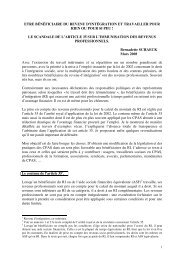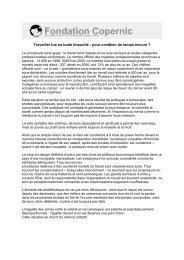Awra Amba RJ 300612 EN - Contacter un comité local d'Attac
Awra Amba RJ 300612 EN - Contacter un comité local d'Attac
Awra Amba RJ 300612 EN - Contacter un comité local d'Attac
Create successful ePaper yourself
Turn your PDF publications into a flip-book with our unique Google optimized e-Paper software.
<strong>Awra</strong> <strong>Amba</strong>, a current experiment of utopian socialism<br />
Atnafu (2005/76-80) measured during his survey the participation of men and women, and of kids<br />
and girls, to household and farming chores, through declaration of people.<br />
Adults <br />
Children <br />
Children <br />
/ adults <br />
Women <br />
(%) <br />
Men <br />
(%) <br />
Women/<br />
men <br />
Girls <br />
(%) <br />
Sample (person number) 80 80 80 80 <br />
Kids <br />
(%) <br />
Girls / <br />
kids <br />
Fetching water 98 69 1.42 31 19 1.67 0.30 <br />
Collecting fire wood 44 99 0.44 6 19 0.33 0.18 <br />
Cooking food 99 71 1.39 9 4 2.33 0.07 <br />
Taking care of animals 99 99 1.00 19 19 1.00 0.19 <br />
Caring for small kids 100 99 1.01 81 69 1.18 0.75 <br />
Bringing goods to market 98 99 0.99 9 14 0.64 0.11 <br />
Washing clothes 88 94 0.93 19 16 1.15 0.19 <br />
Cotton clearing 99 81 1.22 31 29 1.09 0.33 <br />
Spinning 96 88 1.10 19 13 1.50 0.17 <br />
Non weighted average 91 89 1.06 25 22 1.21 0.26 <br />
Table 5:<br />
Participation rate in % to different household chores according to sex and age acc. to<br />
data by Atnafu (2005/76). Colours show the most inegalitarian cases.<br />
The nine identified household chores were equally shared between the sexes, except six of them,<br />
presented below by decreasing order of difference between the sexes (see Table 5):<br />
- Collecting fire wood: men were responsible of that 2.3 times more often than women, kids 3<br />
time more than girls; the reason given for this was that men want to protect females from any<br />
problem they might face outside the village (At05/75);<br />
- Cooking food: women cooked 39 % more than men, girls 2.3 times more than kids,<br />
- Fetching water: women did that 42 % more than men, and girls 67 % more than kids (see<br />
Picture 11),<br />
- Bringing goods to market: girls did that 57 % more than kids, but children rarely made this<br />
activity,<br />
- Spinning: girls did that 50 % more than kids, but children also rarely made this activity,<br />
- Cotton clearing: women did that 22 % more than men.<br />
The difference is very noticeable for collecting fire wood, noticeable for cooking and fetching water,<br />
and low for the three last chores. The few chores made mainly by women do not have lower status<br />
than the traditionally male chores (At05/80). The average participation is slightly higher for women<br />
than for men (91 and 89 %), and for girls than for kids (25 and 22 %): but without knowing the<br />
weight of each of these chores, it is difficult to give a real meaning to these figures.<br />
The eight identified farmer tasks are on average done by men 25 % more than by women (see Table<br />
6). The difference is quite constant between sexes, except for two tasks, which require without doubt<br />
the most physical strength:<br />
- Ploughing: done seven times more by men than by women,<br />
- Threshing: done two times more by men than by women.<br />
However, men as much as women weed the land. In the peak season of agricultural work women<br />
often ask other members of the family (and especially to their older children) to watch their children<br />
and feed them while they work in the fields (At05/78).<br />
50 / 85

















